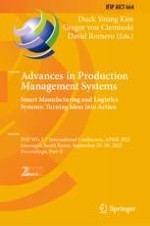This two-volume set, IFIP AICT 663 and 664, constitutes the thoroughly refereed proceedings of the International IFIP WG 5.7 Conference on Advances in Production Management Systems, APMS 2022, held in Gyeongju, South Korea in September 2022.
The 139 full papers presented in these volumes were carefully reviewed and selected from a total of 153 submissions. The papers of APMS 2022 are organized into two parts. The topics of special interest in the first part included: AI & Data-driven Production Management; Smart Manufacturing & Industry 4.0; Simulation & Model-driven Production Management; Service Systems Design, Engineering & Management; Industrial Digital Transformation; Sustainable Production Management; and Digital Supply Networks. The second part included the following subjects: Development of Circular Business Solutions and Product-Service Systems through Digital Twins; “Farm-to-Fork” Production Management in Food Supply Chains; Urban Mobility and City Logistics; Digital Transformation Approaches in Production Management; Smart Supply Chain and Production in Society 5.0 Era; Service and Operations Management in the Context of Digitally-enabled Product-Service Systems; Sustainable and Digital Servitization; Manufacturing Models and Practices for Eco-Efficient, Circular and Regenerative Industrial Systems; Cognitive and Autonomous AI in Manufacturing and Supply Chains; Operators 4.0 and Human-Technology Integration in Smart Manufacturing and Logistics Environments; Cyber-Physical Systems for Smart Assembly and Logistics in Automotive Industry; and Trends, Challenges and Applications of Digital Lean Paradigm.
